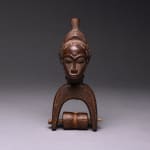Baule Heddle Pulley, 1900 CE - 1950 CE
height 19 cm
height 7 1/2 in
height 7 1/2 in
LSO.256 (DE.075)
Further images
The Baule (or Baoule) people are one of the biggest and most powerful and largest ethnic group in West Africa. Their Ivory Coast homeland lends itself to sedentary agriculturism, so...
The Baule (or Baoule) people are one of the biggest and most powerful and largest ethnic group in West Africa. Their Ivory Coast homeland lends itself to sedentary agriculturism, so they have been able to build up a considerable political and economic stronghold, which has in turn given rise to a strong ritual and artistic heritage. Their own creation story relates to an ancient migration (seemingly from Ghana, escaping the Asante), in which the queen was forced to sacrifice her son in order to ford a mighty river. So upset was she by this that all she could say was “baouli” (“the child is dead”), thus giving rise to the tribe’s name.
The sculptures made by the Baule reflect their belief system, and is intimately linked with the duality of the sexes and the civilised/wild character of the village vs. the ‘bush’. Bush spirits and spirit spouses – otherwordly partners that appear in dreams, and who must be appeased – are notable artistic accomplishments of the Baule, in addition to naturalistic and deconstructed zoomorphic figures and masks, which relate to cultic activity and ceremonial celebration of fertility, agriculture and appeasement of ancestors or potentially harmful natural forces.
In addition to ritually linked art, however, the Baule also delight in the decoration of utilitarian objects, such as containers, staffs and the current heddle pulley. These objects are still used for weaving the dense, colourful fabrics that characterise Central West Africa, and craftsmen rarely miss the opportunity to decorate these everyday objects with naturalistic or geometric motifs that elevate them to outstanding works of art in their own right.
The current example depicts a female’s head as the handle of the pulley, with a serene expression, finely carved facial features and keloid scarifications on the forehead, neck and cheeks. The forehead is high and domed, with geometrically-arranged eyebrow arches incorporated into a “T” with the thin, delicate nose. The tranquil effect of the face is heightened by the small, pursed lips that protrude at the apex of the straight jawline. The coiffure is exceptionally ornate, with a mounted peak of hatched steps culminating in a pierced cylindrical eminence with banded decoration at the very apex of the head. The pulley is decorated with bands of squared, hatched and diamante incised designs, and the whole piece has a beautiful patina of use wear that reflects its considerable age.
The sculptures made by the Baule reflect their belief system, and is intimately linked with the duality of the sexes and the civilised/wild character of the village vs. the ‘bush’. Bush spirits and spirit spouses – otherwordly partners that appear in dreams, and who must be appeased – are notable artistic accomplishments of the Baule, in addition to naturalistic and deconstructed zoomorphic figures and masks, which relate to cultic activity and ceremonial celebration of fertility, agriculture and appeasement of ancestors or potentially harmful natural forces.
In addition to ritually linked art, however, the Baule also delight in the decoration of utilitarian objects, such as containers, staffs and the current heddle pulley. These objects are still used for weaving the dense, colourful fabrics that characterise Central West Africa, and craftsmen rarely miss the opportunity to decorate these everyday objects with naturalistic or geometric motifs that elevate them to outstanding works of art in their own right.
The current example depicts a female’s head as the handle of the pulley, with a serene expression, finely carved facial features and keloid scarifications on the forehead, neck and cheeks. The forehead is high and domed, with geometrically-arranged eyebrow arches incorporated into a “T” with the thin, delicate nose. The tranquil effect of the face is heightened by the small, pursed lips that protrude at the apex of the straight jawline. The coiffure is exceptionally ornate, with a mounted peak of hatched steps culminating in a pierced cylindrical eminence with banded decoration at the very apex of the head. The pulley is decorated with bands of squared, hatched and diamante incised designs, and the whole piece has a beautiful patina of use wear that reflects its considerable age.











